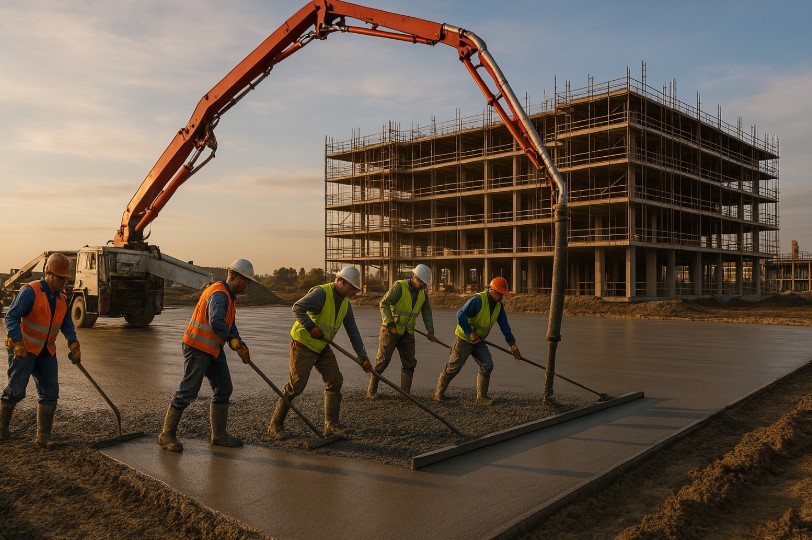Understanding Concrete Placement
Efficient concrete placement is crucial in large-scale construction projects, ensuring strength, durability, and structural integrity. Proper planning, from site preparation to mix design and pouring techniques, helps minimize errors and delays. Advanced placement methods such as pump trucks and conveyor belts allow for a more uniform concrete distribution, reducing labor costs and improving efficiency. Considerations such as weather conditions, timing of the setting, and the reinforcement location need to be thoughtfully evaluated to obtain the best outcomes.
One key application of efficient concrete placement is concrete truck parking lot paving, where durability and load-bearing capacity are critical. The right techniques, including proper subgrade preparation and joint spacing, help prevent cracking and premature wear. By implementing best practices in concrete placement, construction teams can create long-lasting, high-performance surfaces that withstand heavy traffic and environmental conditions.
The Importance of Planning
Concrete placement projects necessitate careful planning, a thorough understanding of project requirements, effective resource allocation, and efficient time management. Strategic planning is essential for the seamless integration of project elements, helping to minimize downtime, prevent cost overruns, and address potential issues such as supply chain disruptions or environmental challenges. Project managers must consider factors like the availability of materials, the necessary equipment, and the workforce’s competencies to create an effective plan. This method guarantees the effective utilization of resources and includes tactics for managing unforeseen circumstances and complexities in projects of this magnitude.
Maximizing Equipment Efficiency
The selection and use of equipment play a vital role in enhancing concrete placement. Contemporary machinery—such as advanced concrete pumps and specialized mixers—is designed to boost efficiency and lessen manual labor. Opting for the appropriate equipment can significantly enhance productivity and decrease the chances of human errors. Customized tools and machinery are key to enabling quick and accurate concrete placement tailored to the specific requirements of each site.
Investing in the right technology also allows construction teams to tackle various environmental challenges, ensuring a consistent mix and timely delivery. Proper maintenance and calibration further enhance the reliability of this equipment, underscoring the importance of equipment management in the project’s overall success.
Streamlining Workforce Coordination
Effective workforce coordination is essential for the success of construction projects. It entails strategic organization, clear task assignments, and ongoing communication at all project levels. This approach ensures that team members are in sync, which enhances productivity and helps adhere to project timelines. Furthermore, continuous training programs inform team members about best practices and new technologies. This cultivates a setting that encourages learning and teamwork, allowing groups to tackle issues efficiently and produce exceptional outcomes throughout the entire duration of a project.
Mitigating Weather Conditions
Weather conditions are a variable that can significantly impact concrete placement and construction timelines. Variables such as temperature fluctuations, wind speeds, and humidity levels can affect curing times and compromise the quality of the finished product. Implementing adaptive measures, such as insulating blankets and admixtures, allows project managers to mitigate adverse effects effectively.
Staying informed about weather forecasts and adopting flexible planning strategies empowers construction teams to adjust their schedules and methodologies accordingly. By proactively addressing potential weather-related issues, teams can safeguard the integrity of their work, conserve resources, and avoid unnecessary delays.
Implementing Safety Protocols
Implementing robust safety protocols is paramount in protecting workers from hazards inherent to concrete placement. This entails assembling a comprehensive safety strategy that includes regular safety briefings, personal protective equipment (PPE) use, and adherence to industry regulations. An effective safety program prevents accidents and creates a culture of safety consciousness across the workforce.
Beyond compliance, a safe working environment contributes to positive morale and project efficiency. By prioritizing safety, project managers can ensure the well-being of their teams, encourage productivity, and build public trust in their construction endeavors.
Future Trends in Concrete Placement
The future of concrete placement is filled with possibilities as technological innovations continue transforming the industry. Developments such as 3D concrete printing, drone technology for site observation, and advanced materials that adjust to environmental factors are changing conventional construction techniques.
These advancements are anticipated to boost the efficiency and speed of construction methods while providing economical options that enhance the quality and sustainability of infrastructure. By keeping up with these trends, construction professionals can position themselves at the forefront of industry progress and set new standards for excellence in concrete placement.
